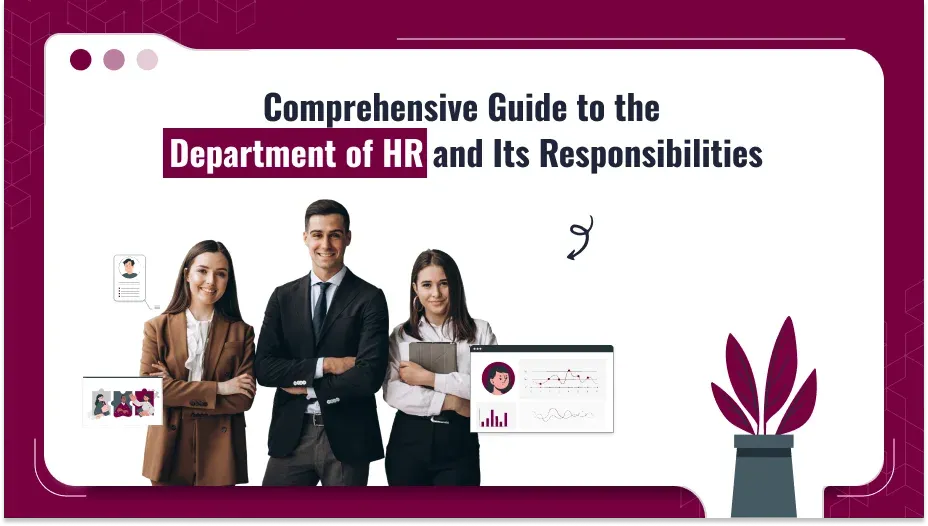
Introduction
The department of HR is the engine that works to manage employees and maintain harmony in organizations. It goes beyond hiring and complying with the requirements to focus on creating a workplace culture that aligns employee goals with the company’s vision. The HR department, as a strategic partner, fuels growth by enhancing productivity, improving employee satisfaction, and driving innovation.
This paper discusses the definition, structure, roles, and current trends of the HR department as it relates to its role in the modern business world.
What is HR Department?
An organization’s HR department is indeed the heart of people management. Its core functions cover hiring and onboarding, as well as other functions such as employee engagement, performance management, and compliance. The HR team is that bridge between employees and management. It is the organization’s way of ensuring organizational goal accomplishment and taking care of its workforce.
For example, a good department of HR is not only concerned with staffing open positions but also ensures that recruits are in line with the company’s culture and strategic objectives. Through solving or preventing workplace issues and also creating good relationships, this HR Development lays down its foundation for sustainable success.
Organization of Human Resource Department
The organization of the human resource department is critical for its effectiveness. The structure depends on the size and needs of the company, but consistency remains in the objective to deliver efficient workforce management.
1. Small Businesses
In small organizations, the different HR functions are handled by an individual or a small team of people. All the work including hiring, payroll, and compliance with the law are performed by these individuals. The simplified structure enables start-ups to focus on key business objectives while fulfilling fundamental HR requirements.
2. Medium-Sized Businesses
Medium-sized businesses usually require a more defined HR team, which has clear roles, such as:
- Recruiters: Attract and hire talent.
- Training Coordinators: Focused on employee development.
- HR Analyst: Use data to improve HR processes.
This division of responsibilities ensures that all aspects of the HR department work are covered efficiently.
3. Large Enterprises
Large organizations often have multi-tiered departments of HR with specialized teams for various functions. For example:
- Employee Relations Teams manage workplace disputes and engagement initiatives.
- Compliance Teams ensure adherence to labor laws.
- Diversity, Equity, and Inclusion Teams promote a balanced and inclusive work environment.
This holistic structure enables the giving of minute attention to every HR function supporting large and diverse workforces.
Transform Your Department of HR with Superworks HRMS!
Enhance employee engagement and streamline HR operations effortlessly.
Types of HR Department Structures
Organizations design their HR departments based on unique needs, goals, and size. Here are the most common HR department structures:
1. Centralized HR Structure
In this structure, all HR functions are managed from a central office. Decisions, policies, and strategies are standardized across the organization. This approach ensures consistency and is often used in large corporations.
Advantages:
- Standardized processes across all departments.
- Easier to implement company-wide policies.
Challenges:
- Limited flexibility for individual departments or regions.
2. Decentralized HR Structure
In decentralized HR, individual departments or business units manage their HR functions. This structure allows for greater flexibility and responsiveness to local needs.
Advantages:
- Tailored HR practices for specific departments.
- Faster response to localized issues.
Challenges:
- Potential inconsistencies in policies and procedures.
3. Matrix HR Structure
The matrix structure integrates HR functions with other organizational departments, encouraging collaboration. HR professionals may report to both Leadership in HR and departmental managers.
Advantages:
- Cross-functional collaboration.
- Increased accountability.
Challenges:
- Complex reporting relationships.
4. Shared Services Model
This model consolidates common HR functions like payroll, benefits, and compliance into a shared services center. It combines efficiency with the ability to provide specialized support.
Advantages:
- Cost-effective and efficient for repetitive tasks.
- Frees up HR teams for strategic functions.
Challenges:
- Requires investment in technology and infrastructure.
5. Outsourced HR
Smaller companies or those aiming to reduce operational burdens may tend to outsource HR services. External providers take over the provision of HR functions such as payroll, compliance, and recruitment, often using Top 10 HR Software in India to make these activities efficient and error-free regarding the management of HR.
Advantages:
- Cost savings for smaller organizations.
- Access to specialized expertise.
Challenges:
- Limited control over HR activities.
The choice of department of HR structure depends on the size, complexity, and strategic priorities of the organization. A startup would go for an outsourced model, but multinational corporations typically use a centralized or shared services model.
Core Roles and Responsibilities of the Department of HR
The HR department roles and responsibilities are broad and encompass various essential functions:
1. Recruitment and Talent Acquisition
The recruitment process is usually the first point of contact for employees with the organization. The department of HR strategizes to attract top talent and ensure a smooth onboarding process.
Example: An HR recruiter will draft job descriptions, use targeted platforms to look for talent, and interview those selected to assess both hard skills and cultural fit.
2. Training and Employee Development
Training programs are critical for upskilling employees. A well-developed human resource manual outlines the organization’s policies on growth opportunities, ensuring consistent employee development.
Example: Companies can offer leadership development programs or technical skills workshops to prepare employees for future roles.
3. Performance Management
The department of HR implements systems to evaluate and enhance employee performance. Regular feedback sessions help an employee’s goals align with those of the organization.
Example: A performance review system would entail quarterly assessments, peer review, and incentives for high performers.
4. Compensation and Benefits
A competitive compensation strategy is of utmost importance in retaining top talent. The HRM Outsourcing team manages payrolls, bonuses, and benefit packages at par with the industry to ensure effectiveness and compliance, allowing the organization to focus on its core business functions.
For example: flexible work arrangements or comprehensive health benefits can attract high-quality candidates.
5. Employee Relations
The HR office acts as a mediator in workplace disputes and ensures a positive work environment. Handling grievance policies and resolving conflict are an important harmony maintenance plan.
6. Compliance and Legal Obligations
HR staff must also be updated on the labor laws of the country and ensure the company is also adhering to them. A well-maintained human resource manual serves as an outline for not getting into any legal complications.
Example: Regular audits of employee documentation and payroll records can help prevent compliance issues.
Developing an HR Department
The developing an HR department careful planning and resource investment are essential for startups or small-scale businesses. Below are steps to establish a robust HR framework:
- Define Objectives Identify the core HR functions required, such as recruitment, training, and compliance.
- Create Policies Develop a human resource manual that outlines company policies, roles, and responsibilities.
- Adopt Technology Implementing tools like HR software for startups can streamline administrative tasks such as payroll and attendance tracking.
- Hire Skilled Professionals Depending on the company size, bring in specialized HR staff to manage different functions effectively.
Strategic Role of the HR Department
The department of HR is a strategic business enabler. Its contributions include:
1. Aligning Goals with Strategy
HR ensures that employee goals align with organizational objectives. By planning for workforce needs and implementing succession strategies, the department of HR supports long-term growth.
Example: An HR might project talent needs in the near future based on projected industry trends and business growth.
2. Developing a Positive Work Culture
The HR team develops a culture of trust, collaboration, and inclusiveness. Initiatives that attract employees and develop diversity are part of this effort.
Example: An organization with a robust DEI initiative often experiences higher employee satisfaction and innovation.
3. Leveraging Data
The current HR department employs the use of HRMS payroll software in India for the analysis of data of the workforce, monitoring of engagement, and proper decision-making.
Trends That Define HR Departments
The HR department is evolving rapidly. Key trends include:
1. Integration of Technology
Automation and AI are revolutionizing HR operations. Tools such as HRMS tools streamline recruitment, payroll processing, and data management.
2. Hybrid Work Models
Remote and hybrid work arrangements have forced HR teams to adopt new strategies for engagement, onboarding, and performance monitoring.
3. Emphasis on DEI
Diversity, equity, and inclusion are at the forefront of modern HR practices, improving team dynamics and innovation.
Challenges in HR Department Work
Despite its critical role, the Department of HR faces challenges:
- Navigating Workplace Conflicts Mediating disputes and maintaining fairness require skillful negotiation.
- Adapting to Changing Regulations The dynamic nature of labor laws means HR professionals must stay informed.
- Management of Employees’ Burnout Preventive measures on burnout occur through wellness programs or work-life balance.
Conclusion
The backbone of an organization is the department of HR. The Human Resources Department is that department which recruits and develops employees and creates a conducive workplace culture.
Modern solutions such as Virtual HR Solutions provide tools to enhance the efficiency of HR, making it possible for businesses to focus better on their core goals. An investment in a solid HR function is an investment in the future of an organization.






